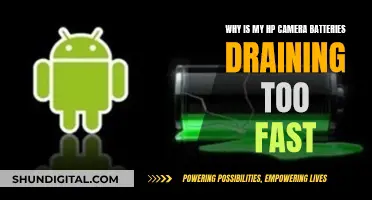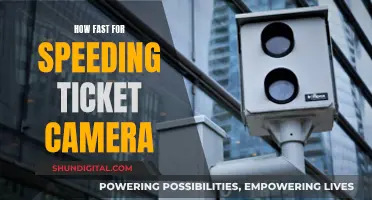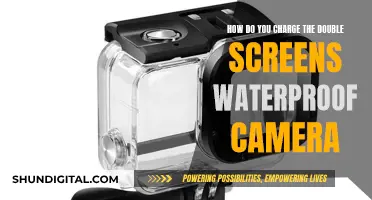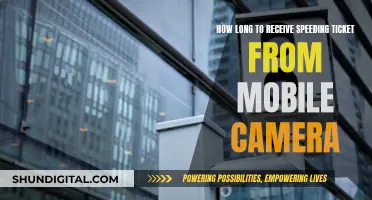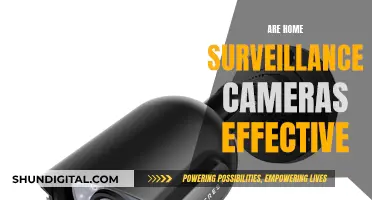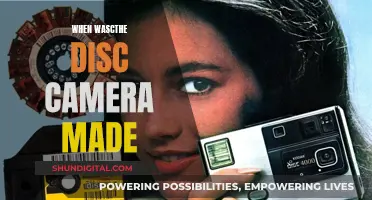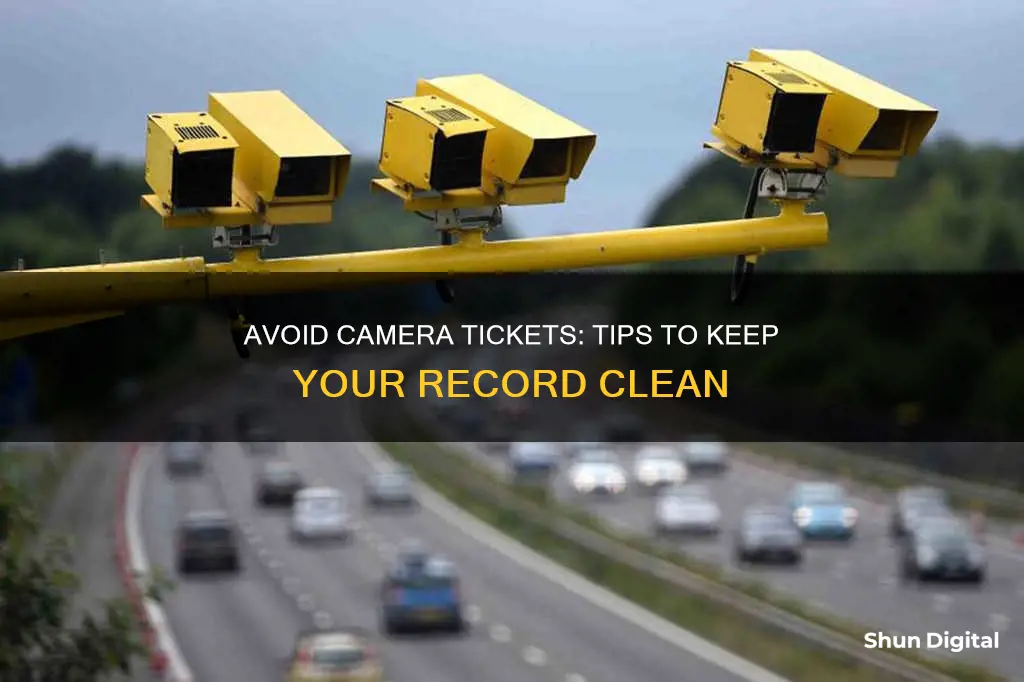
Getting a ticket from a camera can be frustrating, especially when you have to spend days waiting for it to arrive in the mail. However, before you pay up, it's worth knowing that you may have more options than you think. For example, you can check whether the ticket is real, as some US states send out fake tickets, also known as snitch tickets, which are not issued by a court. You can also check the photos included with your citation to confirm that it's your car in the photo, and that the photo is clear. If you weren't driving, you can submit an affidavit naming the actual driver. It's also worth checking the red light law in the jurisdiction where you got the ticket, as some states treat red-light camera tickets like parking violations, holding registered owners liable rather than the driver specifically.
What You'll Learn

Understand the steps involved in the process
Understanding the steps involved in the process of receiving a camera ticket is essential for knowing your rights and options. Here is a detailed breakdown of the process:
Understanding the Violation
Firstly, you will receive a notification that a camera has captured you violating a traffic rule, such as speeding or running a red light. This notification will include details like the date, time, and location of the violation, as well as photos of your car and license plate. It is crucial to examine this information carefully.
Verifying the Details
Check if you were indeed driving the car at the specified date, time, and location. If someone else was driving, you may not be liable, but this depends on the specific jurisdiction. Some states, like New York, treat red-light camera tickets as parking violations, holding the registered owner responsible.
Reviewing the Evidence
Analyze the photos provided. If the photos are blurry or unclear, it may be challenging to confirm that the car is yours. Additionally, if there is no identifiable photo of you in the driver's seat, this can be a point of contention.
Pleading Not Guilty
If you wish to dispute the ticket, you must plead not guilty. Some jurisdictions allow you to do this by mail or online for less serious violations. However, in other cases, you may need to appear in traffic court for an arraignment, where you will plead not guilty and request a formal hearing.
Building Your Defense
While waiting for your hearing, research the applicable laws and precedents in your area. Look for specific rules related to warning signs, traffic light functionality, and other defenses. You can also request documents and maintenance records related to the camera and traffic light system.
Attending the Hearing
Arrive at the courthouse on the scheduled hearing date with any documents or evidence you intend to use in your defense. Present your case respectfully and professionally, addressing any points raised by the prosecutor.
Possible Outcomes
If your defense is successful, the ticket may be dismissed, and you won't have to pay any fines or face penalties. However, if your defense is not accepted, you may have to pay the fine and accept the associated consequences, such as points on your license.
Low Power Mode: Impact on Camera Quality
You may want to see also

Don't respond to the initial traffic complaint
If you've received a traffic ticket by mail, the first thing to do is to check whether it's a real ticket. Fake tickets, or "snitch tickets", are used by many cities in California, Arizona, and possibly other states. These tickets may instruct you not to contact the court and may be missing court contact information. In California, these fake tickets are required to say "Courtesy Notice: This Is Not A Ticket" at the top of the page. You are not required to respond to these tickets, but if you do, a real ticket could be issued.
On the other hand, failing to respond to a real ticket on time can have serious consequences, including additional fines and license suspension. Real tickets should list the name of the court and include a date by which you're required to respond. You can also check the court's case lookup system to confirm whether the ticket is real, but keep in mind that if you can't find it, it may be a real ticket that hasn't been filed yet.
Once you've confirmed that the ticket is real, you have several options, including paying the fine, fighting the ticket, or naming the actual driver if someone else was driving. The procedures for these options vary by state, so be sure to review the laws in your state.
Owner Responsibility vs. Driver Responsibility
In many states, red light camera tickets are treated like parking violations, with responsibility automatically assigned to the registered owner of the vehicle. In these cases, you'll typically have to pay a fine, but no points will appear on your license. However, penalties may change if you fail to respond or if you contest the ticket, so be sure to understand your options before proceeding.
In other states, such as Arizona and California, tickets issued by red light cameras carry the same penalties as tickets issued by an officer, including fines and points on your driving record. In these cases, if someone else was driving your car, you can submit an affidavit naming the actual driver, and the ticket will be reissued to that person.
Fighting the Ticket
If you believe you have grounds to dispute the ticket, you can plead not guilty and request a formal hearing. You may be able to do this by mail or online, depending on your jurisdiction. Be sure to plead not guilty before the deadline, which is typically around 30 days but can vary.
When pleading not guilty, you may be able to argue that:
- The prosecution cannot prove you were driving.
- The photo used as evidence is unclear or unreliable.
- The traffic light or speed monitoring system was not functioning properly.
- Warning signs were obscured or not present.
- You were speeding out of necessity to avoid harm.
Remember to review the specific laws and procedures in your state before taking any action.
Speeding Ticket Cameras: How Fast Before Getting Snapped?
You may want to see also

Formulate a defence strategy
Step 1: Check the ticket details
Check the date, time, and location of the ticket. Confirm that you were actually driving the car when the ticket was issued. If someone else was driving, you may not be liable. Also, check that the ticket has been issued to the correct person and address.
Step 2: Review the photos and videos
If you were driving, try to remember what happened at the time. For example, you may have been making a legal right turn on red. If the photos and videos do not show a violation, you may be able to get the ticket dismissed. Check that the photo is clear and that your license plate is visible. If not, this may be grounds for dismissal.
Step 3: Understand the relevant law
Make a note of the code section you're cited for violating and read up on the law. Understand the elements of the violation and the associated penalties. Research relevant case law in your city or county about traffic cameras. Check if there are any specific rules about warning signs for cameras. If the warning signs were obscured or not present, this may be a valid defence.
Step 4: Plead not guilty
You must plead not guilty if you want to dispute the ticket. Check your citation and ensure you plead not guilty before the deadline, which is typically around 30 days. You may be able to plead by mail or online.
Step 5: Request a formal hearing
When you plead not guilty, demand a full formal hearing or trial. This may require you to attend other hearings such as pre-trial hearings or mediation.
Step 6: Request production of documents
Call the local police department or relevant law enforcement agency to request copies of photos and videos if these were not included with your citation. Also, request full maintenance records for the camera and associated equipment to establish that they were regularly monitored and maintained.
Step 7: Prepare your defence
Arrive at the courthouse on the day of your hearing with copies of any documents you intend to use as evidence. Treat the judge and courthouse staff with respect. Listen quietly while the prosecutor presents their case, making notes of any points you wish to address.
Step 8: Present your defence
Describe the event from your perspective, providing relevant details such as the time, day, intersection, and weather conditions. Point out any discrepancies between your account and the prosecutor's. Reassert your claim and present your evidence, focusing on points that directly challenge the prosecutor's case.
Understanding Close-Up Mode: Getting Creative With Your Camera
You may want to see also

Object to inaccuracies in the plaintiff's statements
Objecting to inaccuracies in the plaintiff's statements is a crucial strategy when fighting a camera ticket. Here are some detailed instructions to help you navigate this process:
Firstly, carefully examine the details of your ticket. Pay close attention to the date, time, and location of the alleged violation. Since camera tickets are typically sent to the vehicle's owner rather than the driver, it's essential to confirm that you were indeed behind the wheel when the incident occurred. If someone else was driving, you cannot be prosecuted. However, some states, like New York, treat red-light camera tickets as parking violations, holding the registered owner responsible. Therefore, it's important to understand the specific laws in your jurisdiction.
Next, scrutinize any photographs or video evidence included with the ticket. If the images are blurry or unclear, it may be challenging to definitively identify your vehicle or license plate. Additionally, if there is no clear photo of you in the driver's seat, the prosecution may struggle to prove that you were the driver. This is especially relevant in jurisdictions where the ticket follows the driver, not the car.
Another angle to explore is the reliability of the camera equipment. Request maintenance records and calibration certifications for the camera, as well as the traffic light or speed monitoring system. If the equipment hasn't been properly maintained or calibrated, the resulting photos may be unreliable as evidence.
Furthermore, investigate the legality of the camera's placement. Many jurisdictions have specific requirements for warning signs that must be posted near traffic cameras. If these signs are missing or not clearly visible, it could be grounds for dismissing the ticket.
If you discover any discrepancies or issues with the evidence presented, be sure to document them thoroughly. This will be crucial when drafting your defence or appeal.
When drafting your formal appeal or defence, be concise, factual, and respectful. Clearly outline why you believe the ticket is unjust and present any supporting evidence or documentation. If relevant, you may also want to highlight any technical issues with the camera equipment or argue that the camera's placement did not adhere to local regulations.
Remember that fighting a camera ticket can be a complex process, and it's always a good idea to seek legal advice or consult a lawyer specializing in traffic violations if you feel unsure about navigating this process on your own.
Understanding Drive Mode in Action Cameras
You may want to see also

Argue that speeding camera photos are hearsay
In some jurisdictions, such as Broward County, Florida, speeding camera photos are considered hearsay. Hearsay is defined as an out-of-court statement presented in court to prove the truth of the matter asserted. In this case, the photo is an out-of-court "statement" that the prosecution is attempting to use to prove you violated the traffic law.
Hearsay evidence is inadmissible unless it fits into one of the exceptions. There are more than two dozen hearsay exceptions, and some courts have fit traffic camera photos into these exceptions, but others have not. If there is no witness present to be cross-examined, an attorney can argue that the substance of the photo evidence is hearsay.
To argue that a speeding camera photo is hearsay, you can:
- Research the issue to find out if this objection is available in your jurisdiction.
- Assert your right to confront witnesses. The Sixth Amendment of the Constitution guarantees you the right to cross-examine witnesses.
- Dispute the authenticity of the photograph. If no one from the company that maintains the camera shows up to testify, object to the use of the photographs for lack of foundation.
- Argue that the photo is not a reasonable representation of its subject and may result in undue prejudice.
Understanding Camera Raw CS4: A Beginner's Guide
You may want to see also
Frequently asked questions
First, make sure it's a real ticket. Some places send out fake tickets, also known as "snitch" tickets, which may instruct you not to contact the court and might be missing court contact information. These tickets are not mandatory to respond to. If it is a real ticket, follow the instructions provided and make sure to do so before the due date indicated.
In most states, it's the driver, not the vehicle owner, who is liable for the violation. Many states allow owners to submit an affidavit stating they were not driving, which typically results in the dismissal of the ticket.
You can plead not guilty by mail, online, or in person at an arraignment, depending on the jurisdiction. If you plead not guilty, request a full formal hearing or trial. Research the applicable laws and build a legal defense. For example, check if there are requirements for warning signs to be posted, or if your state recognizes a necessity defense for speeding.
One strategy is to not respond to the initial "traffic complaint" letter, as these often hold no legal weight. If served, set a hearing and plead "not responsible." Research the violation and the applicable laws to formulate a defense. Object to any inaccurate statements made by the plaintiff and ask questions to discredit their claims. Present your defenses and request a motion to dismiss.
Penalties vary depending on the state. In some states, red light camera tickets carry the same penalties as regular red light violations, including fines and demerit points. However, in most states, camera violation fines are lower, and camera tickets typically don't result in demerit points.


